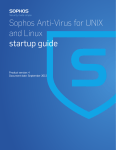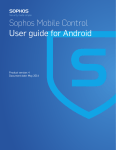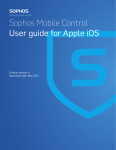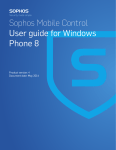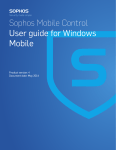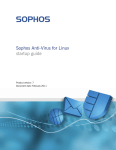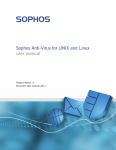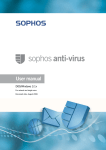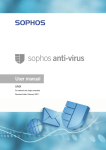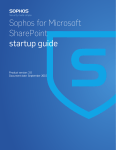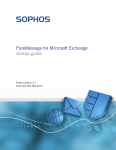Download Sophos Anti-Virus for UNIX and Linux user manual
Transcript
Sophos Anti-Virus for UNIX and Linux user manual Product version: 4 Document date: January 2011 Contents 1 About this manual.....................................................................................................................................3 2 About Sophos Anti-Virus for UNIX and Linux......................................................................................4 3 On-demand scanning...............................................................................................................................5 4 What happens if viruses are detected.......................................................................................................9 5 Cleaning up viruses.................................................................................................................................10 6 Appendix A: On-demand scan return codes.........................................................................................13 7 Troubleshooting......................................................................................................................................15 8 Technical support....................................................................................................................................20 9 Legal notices............................................................................................................................................21 2 user manual 1 About this manual This manual tells you how to use and configure Sophos Anti-Virus for UNIX and Linux. To install Sophos Anti-Virus on standalone and networked UNIX and Linux computers, see the Sophos Anti-Virus for UNIX and Linux startup guide for version 4. To install Sophos Anti-Virus so that it is updated automatically by Sophos Enterprise Console, see the Sophos Endpoint Security and Control startup guide for Linux, NetWare, and UNIX. Sophos documentation is published at www.sophos.com/support/docs/. 3 Sophos Anti-Virus for UNIX and Linux 2 About Sophos Anti-Virus for UNIX and Linux 2.1 What Sophos Anti-Virus does Sophos Anti-Virus detects and deals with viruses (including worms and Trojans) on your UNIX or Linux computer. As well as being able to detect all UNIX and Linux viruses, it can also detect all other viruses that might be stored on your UNIX or Linux computer and transferred to other computers. It does this by scanning your computer. 2.2 How Sophos Anti-Virus protects your computer Sophos Anti-Virus enables you to run an on-demand scan. An on-demand scan is a scan that you initiate. You can scan anything from a single file to everything on your computer that you have permission to read. You can either manually run an on-demand scan or schedule it to run unattended. 2.3 How you use Sophos Anti-Virus Sophos Anti-Virus has a command-line interface. This enables you to access all the Sophos Anti-Virus functionality and to perform all configuration. 4 user manual 3 On-demand scanning An on-demand scan is a scan that you initiate. You can scan anything from a single file to everything on your computer that you have permission to read. You can either manually run an on-demand scan or schedule it to run unattended. To schedule an on-demand scan, use the command crontab. For details, see Sophos support knowledgebase article 12176. 3.1 Running on-demand scans The command that you type to run an on-demand scan is sweep. 3.1.1 Scan the computer ■ To scan the computer, type: sweep / 3.1.2 Scan a particular directory or file ■ To scan a particular directory or file, specify the path of the item. For example, type: sweep /usr/mydirectory/myfile You can type more than one directory or file in the same command. 3.1.3 Scan a filesystem ■ To scan a filesystem, specify its name. For example, type: sweep /home You can type more than one filesystem in the same command. 3.1.4 Scan a boot sector Note: This applies only to Linux and FreeBSD. To scan a boot sector, log in as superuser. This grants you sufficient permission to access the disk devices. You can scan the boot sector of a logical or physical drive. ■ To scan the boot sector of specific logical drives, type: sweep -bs=drive, drive, ... 5 Sophos Anti-Virus for UNIX and Linux where drive is the name of a drive, for example /dev/fd0 or /dev/hda1. ■ To scan the boot sector of all logical drives that Sophos Anti-Virus recognises, type: sweep -bs ■ To scan the master boot record of all fixed physical drives on the computer, type: sweep -mbr 3.2 Configuring on-demand scans In this section, where path appears in a command, it refers to the path to be scanned. To see a full list of the options that you can use with an on-demand scan, type: man sweep 3.2.1 Scan all file types By default, Sophos Anti-Virus scans only executables. To see a full list of the file types that Sophos Anti-Virus scans by default, type sweep -vv. ■ To scan all file types, not just those that are scanned by default, use the option -all. Type: sweep path -all Note: This makes scanning take longer, can compromise performance on servers, and can cause false virus reports. 3.2.2 Scan a particular file type By default, Sophos Anti-Virus scans only executables. To see a full list of the file types that Sophos Anti-Virus scans by default, type sweep -vv. ■ To scan a particular file type, use the option -ext with the appropriate filename extension. For example, to scan files that have the filename extension .txt, type: sweep path -ext=txt ■ To disable scanning of a particular file type, use the option -next with the appropriate filename extension. Note: To specify more than one file type, separate each filename extension with a comma. 3.2.3 Scan inside all archive types You can configure Sophos Anti-Virus to scan inside all archive types. To see a list of these archive types, type sweep -vv. ■ 6 To scan inside all archive types, use the option -archive. Type: user manual sweep path -archive Archives that are “nested” within other archives (for example, a TAR archive within a ZIP archive) are scanned recursively. If you have numerous complex archives, the scan may take longer to run. Bear this in mind when scheduling unattended scans. 3.2.4 Scan inside a particular archive type You can configure Sophos Anti-Virus to scan inside a particular archive type. To see a list of these archive types, type sweep -vv. ■ To scan inside a particular archive type, use the option that is shown in the list. For example, to scan inside TAR and ZIP archives, type: sweep path -tar -zip Archives that are “nested” within other archives (for example, a TAR archive within a ZIP archive) are scanned recursively. If you have numerous complex archives, the scan may take longer to run. Bear this in mind when scheduling unattended scans. 3.2.5 Scan remote computers By default, Sophos Anti-Virus does not scan items on remote computers (that is, does not traverse remote mount points). ■ To scan remote computers, use the option --no-stay-on-machine. Type: sweep path --no-stay-on-machine 3.2.6 Turn off scanning of symbolically linked items By default, Sophos Anti-Virus scans symbolically linked items. ■ To turn off scanning of symbolically linked items, use the option --no-follow-symlinks. Type: sweep path --no-follow-symlinks To avoid scanning items more than once, use the option --backtrack-protection. 3.2.7 Scan the starting filesystem only Sophos Anti-Virus can be configured not to scan items that are beyond the starting filesystem (that is, not to traverse mount points). ■ To scan the starting filesystem only, use the option --stay-on-filesystem. Type: 7 Sophos Anti-Virus for UNIX and Linux sweep path --stay-on-filesystem 3.2.8 Excluding items from scanning You can configure Sophos Anti-Virus to exclude particular items (files, directories, or filesystems) from scanning by using the option -exclude. Sophos Anti-Virus excludes any items that follow the option in the command string. For example, to scan items fred and harry, but not tom or peter, type: sweep fred harry -exclude tom peter You can exclude directories or files that are under a particular directory. For example, to scan all of Fred’s home directory, but exclude the directory games (and all directories and files under it), type: sweep /home/fred -exclude /home/fred/games You can also configure Sophos Anti-Virus to include particular items that follow the option -include. For example, to scan items fred, harry, and bill, but not tom or peter, type: sweep fred harry -exclude tom peter -include bill 3.2.9 Scan file types that UNIX defines as executables By default, Sophos Anti-Virus does not scan file types that UNIX defines as executables. ■ To scan file types that UNIX defines as executables, use the option --examine-x-bit. Type: sweep path --examine-x-bit Sophos Anti-Virus still scans files that have filename extensions that are in its own list as well. To see a list of these filename extensions, type sweep -vv. 8 user manual 4 What happens if viruses are detected If an on-demand scan detects a virus, by default Sophos Anti-Virus displays a command-line alert. It reports the virus on the line which starts with >>> followed by either Virus or Virus Fragment: SWEEP virus detection utility Version 4.58.0 [Linux/Intel] Virus data version 4.58, October 2010 Includes detection for 1375239 viruses, Trojans and worms Copyright (c) 1989-2010 Sophos Group. All rights reserved. System time 13:43:32, System date 22 September 2010 IDE directory is: /usr/savides/ Using IDE file nyrate-d.ide . . . . . . . . . . . . . . Using IDE file injec-lz.ide Quick Scanning >>> Virus 'EICAR-AV-Test' found in file /usr/mydirectory/eicar.src 33 files scanned in 2 seconds. 1 virus was discovered. 1 file out of 33 was infected. Please send infected samples to Sophos for analysis. For advice consult www.sophos.com or email [email protected] End of Sweep. For information about cleaning up viruses, see Cleaning up viruses (section 5). 9 Sophos Anti-Virus for UNIX and Linux 5 Cleaning up viruses 5.1 Get cleanup information If viruses are reported, you can get information and cleanup advice from the Sophos website. To get cleanup information: 1. Go to the security analyses page (http://www.sophos.com/en-us/threat-center/threat-analyses/viruses-and-spyware.aspx). 2. Search for the analysis of the virus, by using the name that was reported by Sophos Anti-Virus. 5.2 Quarantining infected files You can configure an on-demand scan to put infected files into quarantine to prevent them from being accessed. It does this by changing the ownership and permissions for the files. Note: If you specify disinfection (see Cleaning up infected files (section 5.3)) as well as quarantining, Sophos Anti-Virus attempts to disinfect infected items and quarantines them only if disinfection fails. In this section, where path appears in a command, it refers to the path to be scanned. 5.2.1 Specify quarantining ■ To specify quarantining, use the option --quarantine. Type: sweep path --quarantine 5.2.2 Specifying the ownership and permissions that are applied By default, Sophos Anti-Virus changes: ■ The user ownership of an infected file to the user running Sophos Anti-Virus. ■ The group ownership of the file to the group to which that user belongs. ■ The file permissions to -r-------- (0400). If you prefer, you can change the user or group ownership and file permissions that Sophos Anti-Virus applies to infected files. You do so by using these parameters: uid=nnn user=username gid=nnn 10 user manual group=group-name mode=ppp You cannot specify more than one parameter for user ownership or for group ownership. For example, you cannot specify a uid and a user. For each parameter that you do not specify, the default setting (as given earlier) is used. For example: sweep fred --quarantine:user=virus,group=virus,mode=0400 changes an infected file’s user ownership to “virus”, the group ownership to “virus”, and the file permissions to -r--------. This means that the file is owned by the user “virus” and group “virus”, but only the user “virus” can access the file (and only for reading). No-one else (apart from root) can do anything to the file. You may need to be running as a special user or as superuser to set the ownership and permissions. 5.3 Cleaning up infected files You can configure an on-demand scan to clean up (disinfect or delete) infected files. Any actions that Sophos Anti-Virus takes against infected files are listed in the scan summary and logged in the Sophos Anti-Virus log. By default, cleanup is disabled. In this section, where path appears in a command, it refers to the path to be scanned. 5.3.1 Disinfect a specific infected file ■ To disinfect a specific infected file, use the option -di. Type: sweep path -di Sophos Anti-Virus asks for confirmation before it disinfects. Note: Disinfecting an infected document does not repair any changes the virus has made to the document. (See Get cleanup information (section 5.1) to find out how to view details on the Sophos website of the virus’s side-effects.) 5.3.2 Disinfect all infected files on the computer ■ To disinfect all infected files on the computer, type: sweep / -di Sophos Anti-Virus asks for confirmation before it disinfects. Note: Disinfecting an infected document does not repair any changes the virus has made to the document. (See Get cleanup information (section 5.1) to find out how to view details on the Sophos website of the virus’s side-effects.) 11 Sophos Anti-Virus for UNIX and Linux 5.3.3 Delete a specific infected file ■ To delete a specific infected file, use the option -remove. Type: sweep path -remove Sophos Anti-Virus asks for confirmation before it deletes. 5.3.4 Delete all infected files on the computer ■ To delete all infected files on the computer, type: sweep / -remove Sophos Anti-Virus asks for confirmation before it deletes. 5.3.5 Disinfect an infected boot sector Note: This applies only to Linux and FreeBSD. ■ To disinfect an infected boot sector, use the disinfection option -di and the boot sector option -bs. For example, type: sweep -bs=/dev/fd0 -di where /dev/fd0 is the name of the drive that contains the infected boot sector. Sophos Anti-Virus asks for confirmation before it disinfects. 5.4 Recovering from virus side-effects Recovery from virus infection depends on how the virus infected the computer. Some viruses leave you with no side-effects to deal with; others may have such extreme side-effects that you have to restore a hard disk in order to recover. Some viruses gradually make minor changes to data. This type of corruption can be hard to detect. It is therefore very important that you read the virus analysis on the Sophos website, and check documents carefully after disinfection. Sound backups are crucial. If you did not have them before you were infected, start keeping them in case of future infections. Sometimes you can recover data from disks damaged by a virus. Sophos can supply utilities for repairing the damage caused by some viruses. Contact Sophos technical support for advice. 12 user manual 6 Appendix A: On-demand scan return codes sweep returns a code to the shell that indicates the result of the scan. You can view the code by entering a further command after the scan has finished, for example: echo $? Return code Description 0 No errors occur and no viruses are detected 1 The user interrupts the scan by pressing CTRL+C 2 An error occurs that prevents further execution of a scan 3 A virus is detected 6.1 Extended return codes sweep returns a more detailed code to the shell if you run it with the -eec option. You can view the code by entering a further command after the scan has finished, for example: echo $? Extended return code Description 0 No errors occur and no viruses are detected 8 A survivable error occurs 16 A password-protected file is found (it is not scanned) 20 An item containing a virus is detected and disinfected 24 An item containing a virus is found and not disinfected 13 Sophos Anti-Virus for UNIX and Linux 14 Extended return code Description 28 A virus is detected in memory 32 An integrity check failure occurs 36 An unsurvivable error occurs 40 The scan is interrupted user manual 7 Troubleshooting This section describes how to deal with problems that might arise when using Sophos Anti-Virus. For information about Sophos Anti-Virus return codes for on-demand scans, see Appendix A: On-demand scan return codes (section 6). 7.1 Computer reports “not found”, “No manual entry for sweep”, or “cannot load library” Symptom When you try to run sweep or view the sweep man page, the computer displays a message similar to one of the following: command not found man page not found No manual entry for sweep library not found cannot load library Cause This is probably because your environment variables do not include the directories that Sophos Anti-Virus uses. Resolve the problem 1. If you are running the sh, ksh or bash shell, open /etc/profile for editing. If you are running the csh or tcsh shell, open /etc/login for editing. Note: If you do not have a login script or profile, carry out the following steps at the command prompt. You must do this every time that you restart the computer. 2. Check that the environment variables include the directories that Sophos Anti-Virus uses: PATH should include /usr/local/bin MANPATH should include /usr/local/man LD_LIBRARY_PATH should include /usr/local/lib Note: On AIX, the library environment variable is LIBPATH, and on HP-UX it is SHLIB_PATH. 3. If the environment variables do not include these directories, add them as follows. Do not change any of the existing settings. 15 Sophos Anti-Virus for UNIX and Linux If you are running the sh, ksh or bash shell, type: PATH=$PATH:/usr/local/bin export PATH MANPATH=$MANPATH:/usr/local/man export MANPATH LD_LIBRARY_PATH=$LD_LIBRARY_PATH:/usr/local/lib export LD_LIBRARY_PATH If you are running the csh or tcsh shell, type: setenv PATH values:/usr/local/bin setenv MANPATH values:/usr/local/man setenv LD_LIBRARY_PATH values:/usr/local/lib where values are the existing settings. Note: On some systems, for example FreeBSD and Linux, you can enable Sophos Anti-Virus to use the Sophos Anti-Virus shared libraries by running ldconfig. This might require editing of /etc/ld.so.conf. 4. Save the login script or profile. 7.2 Sophos Anti-Virus runs out of disk space Symptom Sophos Anti-Virus runs out of disk space, perhaps when scanning complex archives. Causes This might be for one of the following reasons: ■ When it unpacks archives, Sophos Anti-Virus uses the /tmp directory to store its working results. If this directory is not very large, Sophos Anti-Virus may run out of disk space. ■ Sophos Anti-Virus has exceeded the user’s quota. Resolve the problem Try one of the following: 16 ■ Enlarge /tmp. ■ Increase the user’s quota. ■ Change the directory that Sophos Anti-Virus uses for working results. You can do this by setting the environment variable SAV_TMP. user manual 7.3 On-demand scanning runs slowly This problem may arise for one of the following reasons: Symptom Sophos Anti-Virus takes significantly longer to carry out an on-demand scan. Causes This might be for one of the following reasons: ■ By default, Sophos Anti-Virus performs a quick scan, which scans only the parts of files that are likely to contain viruses. If scanning is set to full (using the option -f), it scans the whole file. ■ By default, Sophos Anti-Virus scans only particular file types. If it is configured to scan all file types, the process takes longer. Resolve the problem Try one of the following, as appropriate: ■ Avoid using full scanning unless you are advised to, for example by Sophos technical support. ■ To scan files that have specific filename extensions, add those extensions to the list of file types that Sophos Anti-Virus scans by default. For more information, see Scan a particular file type (section 3.2.2). 7.4 Archiver backs up all files that have been scanned on demand Symptom Your archiver always backs up all the files that Sophos Anti-Virus has scanned on demand. Cause This is because of changes that Sophos Anti-Virus makes in the “status-changed” time of files. By default, Sophos Anti-Virus tries to reset the access time (atime) of files to the time shown before scanning. However, this has the effect of changing the inode status-changed time (ctime). If your archiver uses the ctime to decide whether a file has changed, it backs up all files scanned by Sophos Anti-Virus. Resolve the problem Run sweep with the option --no-reset-atime. 17 Sophos Anti-Virus for UNIX and Linux 7.5 Virus not cleaned up Symptoms ■ Sophos Anti-Virus has not attempted to clean up a virus. ■ Sophos Anti-Virus displays Disinfection failed. Causes This might be for one of the following reasons: ■ Automatic cleanup has not been enabled. ■ Sophos Anti-Virus cannot disinfect that type of virus. ■ The infected file is on a removable medium, for example floppy disk or CD, that is write-protected. ■ The infected file is on an NTFS filesystem. ■ Sophos Anti-Virus does not clean up a virus fragment because it has not found an exact virus match. Resolve the problem Try one of the following, as appropriate: ■ Enable automatic cleanup. ■ If possible, make the removable medium writeable. ■ Deal with files that are on an NTFS filesystem on the local computer instead. 7.6 Virus fragment reported Symptom Sophos Anti-Virus reports that it has detected a virus fragment. Causes This indicates that part of a file matches part of a virus. This is for one of the following reasons: 18 ■ Many new viruses are based on existing ones. Therefore, code fragments that are typical of a known virus might appear in files that are infected with a new one. ■ Many viruses contain bugs in their replication routines that cause them to infect target files incorrectly. An inactive part of the virus (possibly a substantial part) may appear in the host file, and this is detected by Sophos Anti-Virus. ■ When running a full scan, Sophos Anti-Virus may report that there is a virus fragment in a database file. user manual Resolve the problem 1. Update Sophos Anti-Virus on the affected computer so that it has the latest virus data. 2. Try to disinfect the file: see Disinfect a specific infected file (section 5.3.1). 3. If virus fragments are still reported, contact Sophos technical support for advice. 19 Sophos Anti-Virus for UNIX and Linux 8 Technical support You can find technical support for Sophos products in any of these ways: 20 ■ Visit the SophosTalk community at community.sophos.com/ and search for other users who are experiencing the same problem. ■ Visit the Sophos support knowledgebase at www.sophos.com/en-us/support.aspx. ■ Download the product documentation at www.sophos.com/en-us/support/documentation/. ■ Send an email to [email protected], including your Sophos software version number(s), operating system(s) and patch level(s), and the text of any error messages. user manual 9 Legal notices Copyright © 2014 Sophos Limited. All rights reserved. No part of this publication may be reproduced, stored in a retrieval system, or transmitted, in any form or by any means, electronic, mechanical, photocopying, recording or otherwise unless you are either a valid licensee where the documentation can be reproduced in accordance with the license terms or you otherwise have the prior permission in writing of the copyright owner. Sophos, Sophos Anti-Virus and SafeGuard are registered trademarks of Sophos Limited, Sophos Group and Utimaco Safeware AG, as applicable. All other product and company names mentioned are trademarks or registered trademarks of their respective owners. dtoa.c The author of this software is David M. Gay. Copyright © 1991, 2000 by Lucent Technologies. Permission to use, copy, modify, and distribute this software for any purpose without fee is hereby granted, provided that this entire notice is included in all copies of any software which is or includes a copy or modification of this software and in all copies of the supporting documentation for such software. THIS SOFTWARE IS BEING PROVIDED "AS IS", WITHOUT ANY EXPRESS OR IMPLIED WARRANTY. IN PARTICULAR, NEITHER THE AUTHOR NOR LUCENT MAKES ANY REPRESENTATION OR WARRANTY OF ANY KIND CONCERNING THE MERCHANTABILITY OF THIS SOFTWARE OR ITS FITNESS FOR ANY PARTICULAR PURPOSE. fenv.h (applicable to FreeBSD only) Copyright (c) 2004-2005 David Schultz ([email protected]) All rights reserved. Redistribution and use in source and binary forms, with or without modification, are permitted provided that the following conditions are met: 1. Redistributions of source code must retain the above copyright notice, this list of conditions and the following disclaimer. 2. Redistributions in binary form must reproduce the above copyright notice, this list of conditions and the following disclaimer in the documentation and/or other materials provided with the distribution. THIS SOFTWARE IS PROVIDED BY THE AUTHOR AND CONTRIBUTORS "AS IS" AND ANY EXPRESS OR IMPLIED WARRANTIES, INCLUDING, BUT NOT LIMITED TO, THE IMPLIED WARRANTIES OF MERCHANTABILITY AND FITNESS FOR A PARTICULAR PURPOSE ARE DISCLAIMED. IN NO EVENT SHALL THE AUTHOR OR CONTRIBUTORS BE LIABLE FOR ANY DIRECT, INDIRECT, INCIDENTAL, SPECIAL, EXEMPLARY, OR CONSEQUENTIAL DAMAGES (INCLUDING, BUT NOT LIMITED TO, PROCUREMENT OF SUBSTITUTE GOODS OR SERVICES; LOSS OF USE, DATA, OR PROFITS; OR BUSINESS INTERRUPTION) HOWEVER CAUSED AND ON ANY THEORY OF LIABILITY, WHETHER IN CONTRACT, 21 Sophos Anti-Virus for UNIX and Linux STRICT LIABILITY, OR TORT (INCLUDING NEGLIGENCE OR OTHERWISE) ARISING IN ANY WAY OUT OF THE USE OF THIS SOFTWARE, EVEN IF ADVISED OF THE POSSIBILITY OF SUCH DAMAGE. OpenSSL Cryptography and SSL/TLS Toolkit The OpenSSL toolkit stays under a dual license, i.e. both the conditions of the OpenSSL License and the original SSLeay license apply to the toolkit. See below for the actual license texts. Actually both licenses are BSD-style Open Source licenses. In case of any license issues related to OpenSSL please contact [email protected]. OpenSSL license Copyright © 1998–2011 The OpenSSL Project. All rights reserved. Redistribution and use in source and binary forms, with or without modification, are permitted provided that the following conditions are met: 1. Redistributions of source code must retain the above copyright notice, this list of conditions and the following disclaimer. 2. Redistributions in binary form must reproduce the above copyright notice, this list of conditions and the following disclaimer in the documentation and/or other materials provided with the distribution. 3. All advertising materials mentioning features or use of this software must display the following acknowledgment: “This product includes software developed by the OpenSSL Project for use in the OpenSSL Toolkit. (http://www.openssl.org/)” 4. The names “OpenSSL Toolkit” and “OpenSSL Project” must not be used to endorse or promote products derived from this software without prior written permission. For written permission, please contact [email protected]. 5. Products derived from this software may not be called “OpenSSL” nor may “OpenSSL” appear in their names without prior written permission of the OpenSSL Project. 6. Redistributions of any form whatsoever must retain the following acknowledgment: “This product includes software developed by the OpenSSL Project for use in the OpenSSL Toolkit (http://www.openssl.org/)” THIS SOFTWARE IS PROVIDED BY THE OpenSSL PROJECT “AS IS” AND ANY EXPRESSED OR IMPLIED WARRANTIES, INCLUDING, BUT NOT LIMITED TO, THE IMPLIED WARRANTIES OF MERCHANTABILITY AND FITNESS FOR A PARTICULAR PURPOSE ARE DISCLAIMED. IN NO EVENT SHALL THE OpenSSL PROJECT OR ITS CONTRIBUTORS BE LIABLE FOR ANY DIRECT, INDIRECT, INCIDENTAL, SPECIAL, EXEMPLARY, OR CONSEQUENTIAL DAMAGES (INCLUDING, BUT NOT LIMITED TO, PROCUREMENT OF SUBSTITUTE GOODS OR SERVICES; LOSS OF USE, DATA, OR PROFITS; OR BUSINESS INTERRUPTION) HOWEVER CAUSED AND ON ANY THEORY OF LIABILITY, WHETHER IN CONTRACT, STRICT LIABILITY, OR TORT (INCLUDING NEGLIGENCE OR OTHERWISE) ARISING IN ANY WAY OUT OF THE USE OF THIS SOFTWARE, EVEN IF ADVISED OF THE POSSIBILITY OF SUCH DAMAGE. 22 user manual This product includes cryptographic software written by Eric Young ([email protected]). This product includes software written by Tim Hudson ([email protected]). Original SSLeay license Copyright © 1995–1998 Eric Young ([email protected]) All rights reserved. This package is an SSL implementation written by Eric Young ([email protected]). The implementation was written so as to conform with Netscape’s SSL. This library is free for commercial and non-commercial use as long as the following conditions are adhered to. The following conditions apply to all code found in this distribution, be it the RC4, RSA, lhash, DES, etc., code; not just the SSL code. The SSL documentation included with this distribution is covered by the same copyright terms except that the holder is Tim Hudson ([email protected]). Copyright remains Eric Young’s, and as such any Copyright notices in the code are not to be removed. If this package is used in a product, Eric Young should be given attribution as the author of the parts of the library used. This can be in the form of a textual message at program startup or in documentation (online or textual) provided with the package. Redistribution and use in source and binary forms, with or without modification, are permitted provided that the following conditions are met: 1. Redistributions of source code must retain the copyright notice, this list of conditions and the following disclaimer. 2. Redistributions in binary form must reproduce the above copyright notice, this list of conditions and the following disclaimer in the documentation and/or other materials provided with the distribution. 3. All advertising materials mentioning features or use of this software must display the following acknowledgement: “This product includes cryptographic software written by Eric Young ([email protected])” The word “cryptographic” can be left out if the routines from the library being used are not cryptographic related :-). 4. If you include any Windows specific code (or a derivative thereof) from the apps directory (application code) you must include an acknowledgement: “This product includes software written by Tim Hudson ([email protected])” THIS SOFTWARE IS PROVIDED BY ERIC YOUNG “AS IS” AND ANY EXPRESS OR IMPLIED WARRANTIES, INCLUDING, BUT NOT LIMITED TO, THE IMPLIED WARRANTIES OF MERCHANTABILITY AND FITNESS FOR A PARTICULAR PURPOSE ARE DISCLAIMED. IN NO EVENT SHALL THE AUTHOR OR CONTRIBUTORS BE LIABLE FOR ANY DIRECT, INDIRECT, INCIDENTAL, SPECIAL, EXEMPLARY, OR CONSEQUENTIAL DAMAGES (INCLUDING, BUT NOT LIMITED TO, PROCUREMENT OF SUBSTITUTE GOODS OR SERVICES; LOSS OF USE, DATA, OR PROFITS; OR BUSINESS INTERRUPTION) HOWEVER CAUSED AND ON ANY THEORY OF LIABILITY, WHETHER IN CONTRACT, STRICT LIABILITY, OR TORT (INCLUDING NEGLIGENCE OR OTHERWISE) ARISING IN ANY WAY 23 Sophos Anti-Virus for UNIX and Linux OUT OF THE USE OF THIS SOFTWARE, EVEN IF ADVISED OF THE POSSIBILITY OF SUCH DAMAGE. The license and distribution terms for any publically available version or derivative of this code cannot be changed. i.e. this code cannot simply be copied and put under another distribution license [including the GNU Public License.] Protocol Buffers Copyright 2008, Google Inc. All rights reserved. Redistribution and use in source and binary forms, with or without modification, are permitted provided that the following conditions are met: ■ Redistributions of source code must retain the above copyright notice, this list of conditions and the following disclaimer. ■ Redistributions in binary form must reproduce the above copyright notice, this list of conditions and the following disclaimer in the documentation and/or other materials provided with the distribution. ■ Neither the name of Google Inc. nor the names of its contributors may be used to endorse or promote products derived from this software without specific prior written permission. THIS SOFTWARE IS PROVIDED BY THE COPYRIGHT HOLDERS AND CONTRIBUTORS "AS IS" AND ANY EXPRESS OR IMPLIED WARRANTIES, INCLUDING, BUT NOT LIMITED TO, THE IMPLIED WARRANTIES OF MERCHANTABILITY AND FITNESS FOR A PARTICULAR PURPOSE ARE DISCLAIMED. IN NO EVENT SHALL THE COPYRIGHT OWNER OR CONTRIBUTORS BE LIABLE FOR ANY DIRECT, INDIRECT, INCIDENTAL, SPECIAL, EXEMPLARY, OR CONSEQUENTIAL DAMAGES (INCLUDING, BUT NOT LIMITED TO, PROCUREMENT OF SUBSTITUTE GOODS OR SERVICES; LOSS OF USE, DATA, OR PROFITS; OR BUSINESS INTERRUPTION) HOWEVER CAUSED AND ON ANY THEORY OF LIABILITY, WHETHER IN CONTRACT, STRICT LIABILITY, OR TORT (INCLUDING NEGLIGENCE OR OTHERWISE) ARISING IN ANY WAY OUT OF THE USE OF THIS SOFTWARE, EVEN IF ADVISED OF THE POSSIBILITY OF SUCH DAMAGE. Simple ECMAScript Engine Copyright © 2003, 2004, 2005, 2006, 2007 David Leonard. All rights reserved. Redistribution and use in source and binary forms, with or without modification, are permitted provided that the following conditions are met: 1. Redistributions of source code must retain the above copyright notice, this list of conditions and the following disclaimer. 2. Redistributions in binary form must reproduce the above copyright notice, this list of conditions and the following disclaimer in the documentation and/or other materials provided with the distribution. 24 user manual 3. Neither the name of David Leonard nor the names of its contributors may be used to endorse or promote products derived from this software without specific prior written permission. THIS SOFTWARE IS PROVIDED BY THE COPYRIGHT HOLDERS AND CONTRIBUTORS “AS IS” AND ANY EXPRESS OR IMPLIED WARRANTIES, INCLUDING, BUT NOT LIMITED TO, THE IMPLIED WARRANTIES OF MERCHANTABILITY AND FITNESS FOR A PARTICULAR PURPOSE ARE DISCLAIMED. IN NO EVENT SHALL THE COPYRIGHT OWNER OR CONTRIBUTORS BE LIABLE FOR ANY DIRECT, INDIRECT, INCIDENTAL, SPECIAL, EXEMPLARY, OR CONSEQUENTIAL DAMAGES (INCLUDING, BUT NOT LIMITED TO, PROCUREMENT OF SUBSTITUTE GOODS OR SERVICES; LOSS OF USE, DATA, OR PROFITS; OR BUSINESS INTERRUPTION) HOWEVER CAUSED AND ON ANY THEORY OF LIABILITY, WHETHER IN CONTRACT, STRICT LIABILITY, OR TORT (INCLUDING NEGLIGENCE OR OTHERWISE) ARISING IN ANY WAY OUT OF THE USE OF THIS SOFTWARE, EVEN IF ADVISED OF THE POSSIBILITY OF SUCH DAMAGE. strcasestr.c Copyright © 1990, 1993 The Regents of the University of California. All rights reserved. This code is derived from software contributed to Berkeley by Chris Torek. Redistribution and use in source and binary forms, with or without modification, are permitted provided that the following conditions are met: 1. Redistributions of source code must retain the above copyright notice, this list of conditions and the following disclaimer. 2. Redistributions in binary form must reproduce the above copyright notice, this list of conditions and the following disclaimer in the documentation and/or other materials provided with the distribution. 3. Neither the name of the University nor the names of its contributors may be used to endorse or promote products derived from this software without specific prior written permission. THIS SOFTWARE IS PROVIDED BY THE REGENTS AND CONTRIBUTORS “AS IS” AND ANY EXPRESS OR IMPLIED WARRANTIES, INCLUDING, BUT NOT LIMITED TO, THE IMPLIED WARRANTIES OF MERCHANTABILITY AND FITNESS FOR A PARTICULAR PURPOSE ARE DISCLAIMED. IN NO EVENT SHALL THE REGENTS OR CONTRIBUTORS BE LIABLE FOR ANY DIRECT, INDIRECT, INCIDENTAL, SPECIAL, EXEMPLARY, OR CONSEQUENTIAL DAMAGES (INCLUDING, BUT NOT LIMITED TO, PROCUREMENT OF SUBSTITUTE GOODS OR SERVICES; LOSS OF USE, DATA, OR PROFITS; OR BUSINESS INTERRUPTION) HOWEVER CAUSED AND ON ANY THEORY OF LIABILITY, WHETHER IN CONTRACT, STRICT LIABILITY, OR TORT (INCLUDING NEGLIGENCE OR OTHERWISE) ARISING IN ANY WAY OUT OF THE USE OF THIS SOFTWARE, EVEN IF ADVISED OF THE POSSIBILITY OF SUCH DAMAGE. UnRAR The source code of UnRAR utility is freeware. This means: 1. All copyrights to RAR and the utility UnRAR are exclusively owned by the author - Alexander Roshal. 25 Sophos Anti-Virus for UNIX and Linux 2. The UnRAR sources may be used in any software to handle RAR archives without limitations free of charge, but cannot be used to re-create the RAR compression algorithm, which is proprietary. Distribution of modified UnRAR sources in separate form or as a part of other software is permitted, provided that it is clearly stated in the documentation and source comments that the code may not be used to develop a RAR (WinRAR) compatible archiver. 3. The UnRAR utility may be freely distributed. It is allowed to distribute UnRAR inside of other software packages. 4. THE RAR ARCHIVER AND THE UnRAR UTILITY ARE DISTRIBUTED “AS IS”. NO WARRANTY OF ANY KIND IS EXPRESSED OR IMPLIED. YOU USE AT YOUR OWN RISK. THE AUTHOR WILL NOT BE LIABLE FOR DATA LOSS, DAMAGES, LOSS OF PROFITS OR ANY OTHER KIND OF LOSS WHILE USING OR MISUSING THIS SOFTWARE. 5. Installing and using the UnRAR utility signifies acceptance of these terms and conditions of the license. 6. If you don’t agree with terms of the license you must remove UnRAR files from your storage devices and cease to use the utility. Thank you for your interest in RAR and UnRAR. Alexander L. Roshal zlib compression tools © 1995–2002 Jean-loup Gailly and Mark Adler This software is provided ‘as-is’, without any express or implied warranty. In no event will the authors be held liable for any damages arising from the use of this software. Permission is granted to anyone to use this software for any purpose, including commercial applications, and to alter it and redistribute it freely, subject to the following restrictions: 1. The origin of this software must not be misrepresented; you must not claim that you wrote the original software. If you use this software in a product, an acknowledgment in the product documentation would be appreciated but is not required. 2. Altered source versions must be plainly marked as such, and must not be misrepresented as being the original software. 3. This notice may not be removed or altered from any source distribution. Jean-loup Gailly [email protected] Mark Adler [email protected] If you use the zlib library in a product, we would appreciate *not* receiving lengthy legal documents to sign. The sources are provided for free but without warranty of any kind. The library has been entirely written by Jean-loup Gailly and Mark Adler; it does not include third-party code. If you redistribute modified sources, we would appreciate that you include in the file ChangeLog history information documenting your changes. 26 user manual Index F A alerts 9 command-line 9 analyses of viruses 10 archives 6–7 on-demand scans file types, on-demand scans 6, 8 files, on-demand scans 5 filesystems, on-demand scans 5, 7 fragment reported, viruses 18 6–7 I B infected files 10–12 cleaning up 11 deleting 12 disinfecting 11 quarantining 10 backups of scanned files 17 boot sectors 5, 12 disinfecting 12 on-demand scans 5 L C cannot load library 15 cleaning up infected files 11 cleanup information 10 CLI (command-line interface) 4 command not found 15 command-line alerts 9 command-line interface (CLI) 4 computer, on-demand scans 5 library not found D O deleting infected files 12 directories, on-demand scans disinfecting 11–12 boot sectors 12 infected files 11 disk space insufficient 16 E error codes 13 excluding items 8 on-demand scans 8 5 15 M man page not found 15 N No manual entry for sweep 15 on-demand scans 5–8 archives 6–7 boot sectors 5 computer 5 directories 5 excluding items 8 file types 6, 8 files 5 filesystems 5, 7 remote computers 7 symbolically linked items 7 27 Sophos Anti-Virus for UNIX and Linux on-demand scans (continued) UNIX executables 8 slow on-demand scans 17 symbolically linked items, on-demand scans Q U quarantining infected files 10 UNIX executables, on-demand scans R V remote computers, on-demand scans return codes 13 S side-effects of viruses 28 12 7 viruses 9–10, 12, 18 analyses 10 detected 9 fragment reported 18 not cleaned up 18 side-effects 12 8 7




























